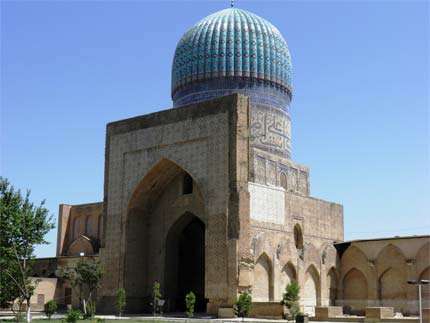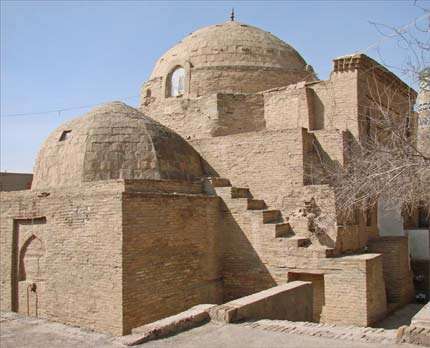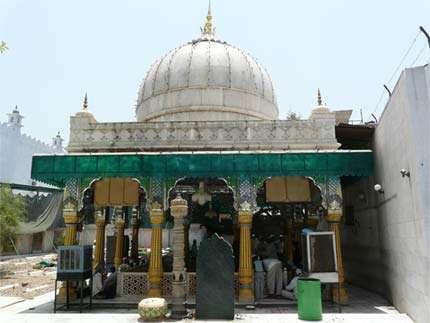Chapter 3
"Eastern art has a mathematical basis. It is a script with an esoteric and an exoteric content. In Persia there is a room in a monastery where one bursts into tears because of a combination of the various parts of its architecture." Gurdjieff
The first remarkable fact that one observes
when entering tombs of Sufi saints is the total absence of any dreary or
depressing vibration. On the contrary, one finds the atmosphere uplifting
and helpful for concentration. After visiting several mazars I noticed a
difference in etheric density at each tomb. Besides the stage of Perfection
reached by the saint, the influence of the other visitors and one's own
degree of spiritual discernment at the moment of visitation, also the geographical
situation of the tomb, its building material and architecture seem to be
an important factor in explaining the difference in density.
The structure
of particular mausoleums, mosques and houses helps to conserve and generate
subtle energies. Of Fazl-Ullah of Asterabad, the founder of the Persian
Hurufi sect who lived in the fourteenth century, it is known that he owed
a decisive religious experience to a stay in a special building in Ispahan.
Every form creates a field of radiation. Form is
condensation of waves, radiations and vibrations. Specific forms placed
in a definite proportion create a specific field of power. In Torbat-i-Jam
in North-East Persia, uninitiated restorers in 1971 had completely removed
the crumbled front wall of the shrine of Ahmad-i-Jami and replaced it by
an iron fence which caused a leak in the energy-preserving building.
In 1975 the error was recognized and a new wall was constructed. Just as
sounds are canalized by forms, so too are etheric vibrations conducted by
them.
It is known that tombs have become empty because the area around
them has been cut to pieces for the construction of buildings and roads.
Geometric designs on the walls of mosques and mazars express the eternal
laws of creation. These archetypal designs activate corresponding subtle
energies in the subconscious of the visitor. The patterns on walls are reflections
of currents of energy and powers in the universe and in man.
Contemplation
of these geometric figures can bring hidden forces within the field of our
consciousness. Some figures in the majolica decoration and in carpets are
representations of jinns. Other patterns remind us of dynamic flashes of
extradimensional light.
The dome on a square or octagonal basis constructed
over the grave of a saint mirrors the Perfect Mind of the dervish. Poetic
expressions concerning the domes of tombs contain an esoteric meaning. A
verse praising Timur's tomb in Samarkand says: "When the sky disappears,
the dome of the Gur-i-Emir takes its place".

Timur's tomb in Samarkand
Another inscription on the stucco covering in the mausoleum of Sheikh Ala'ud-Din in Khiva reads: "This dome was constructed in olden times; because of it, the revolving dome (i.e. the sky) is devoured by envy".

Mausoleum of Sheikh Syed Alauddin in Khina, Uzbekistan
These verses are hints
to a spiritual stage, rather than esthetic evaluations. The mausoleum in
Khiva was built in the fourteenth century and in comparison with other monuments
it looks heavy and squat. So the jealousy of the sky must have another cause.
The revolving dome of the sky symbolizes the phenomenal world and the dome
of the mausoleum stands for the clear mind of the dervish empty of attachments
and emotions for the external world.
The mehrab in mosques and the niche
in prayer carpets are doors to other worlds. The famous prayer carpets preserved
in the Topkapi Palace are like windows through which we are blessed with
visions of the Names of Allah (There are carpets that reflect in their
abstract geometric patterns the creative forces in the universe and in man.
These carpets, like holy scriptures preserve millenia old diagrams and symbols
which are a magico-mystical treasure. Some of them have all the characteristics
of the structure of the mandala. Others reflect the dynamism and rhythm
of latent psychic energies. The abstract geometric patterns are forms of
energy. In and around the central field we see representations of protective
jinns and magical diagrams, and in the borders separated by guardian stripes
we find rows of amulets.).
Some landscapes and places are more favorable
for building a mosque or a mazar than others. There are traditions which
relate that in ancient times heavenly light was deposited in particular
places on earth. In choosing a spot for a monastery the Bektashis applied
the laws of geomancy. The aim of constructing mosques and convents at particular
spots considered auspicious was to activate and actualize the latent spiritual
forces inherent both in man and in nature. Some spots possess hidden powers,
while others are believed to be inhabited by malicious jinns.
In the
convent of Ahmad al-Kabir in Blida is a cave considered to be a gate to
other worlds. When visiting the cave some pilgrims have strange visions.
Often a saint indicates before his death the place where he wants to be
buried. It is known of Khaja Qutub ud-Din Kaki that a few weeks before his
death while he was on a walk, he stood still at a place and said: "I
feel the smell of love coming out of here. Here I will rest." The owner
of the land was called and the land purchased. When the sheikh had died
his body was brought to the spot and buried there.
Tomb of Sufi saint, Qutbuddin Bakhtiyar Kaki in Mehrauli, Delhi
